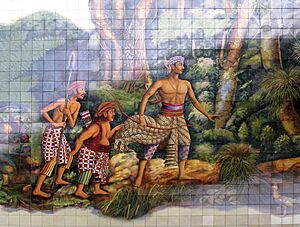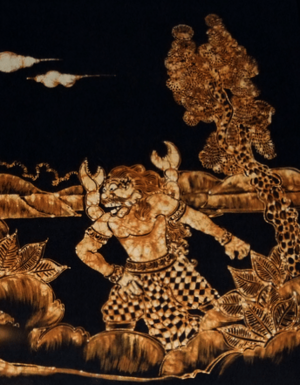Panji tales facts for kids
Quick facts for kids Panji tales |
|
|---|---|

Raden Panji Inu Kertapati searching for his lost wife, Dewi Sekartaji
|
|
| Folk tale | |
| Name | Panji tales |
| Data | |
| Mythology | Javanese |
| Country | Indonesia |
| Region | Java |
| Origin Date | before 1400 |
The Panji tales are a famous collection of stories from Java, Indonesia. They are all about a legendary prince named Panji. These stories are as important as the Ramayana and Mahabharata in Javanese culture. They inspire many things like poems, art, dance, and different types of wayang (shadow puppet shows).
You can see Panji tales in traditional Indonesian dances. This includes the topeng (mask) dances from Cirebon and Malang. They also inspire the gambuh dance-drama in Bali. The Panji tales started in East Java and spread across Southeast Asia. This includes countries like Thailand, Cambodia, Laos, Myanmar, and Malaysia.
Contents
Where Did Panji Tales Begin?
The name Panji is actually a Javanese title. It means 'banner' or 'flag'. In these stories, Prince Panji does brave deeds. Some experts think the tales might be based on ancient myths about the sun and moon.
Early scholars believed Prince Panji might be based on a real king. This king was Kameçvara, who ruled Kediri in the 12th century. His queen, Çri Kirana, might have inspired Princess Candra Kirana. This idea comes from an old poem called Smaradhana.
The poem says the spirits of the love god Kamajaya and his wife Kamaratih fell to Earth. They were reborn as Prince Panji and Princess Candra Kirana. However, the kingdoms in the tales don't quite match history. Panji was from Janggala in the stories, but King Kameçvara was from Kediri.
Panji in Art and Performances
You can see scenes from the Panji tales in old Javanese temples. These are called candi. The earliest examples are from the 13th century, like Candi Jawi. By the 14th century, a figure wearing Panji's special cap appeared in many temple carvings. This shows Panji was an important figure, maybe even worshipped.
A famous Javanese saint, Sunan Giri, helped create wayang gedog in 1553. This type of puppet show was made to tell the Panji stories. Wayang kulit (leather puppet) shows also perform Panji tales. There are also wayang klitik (wooden puppets) and wayang golek (three-dimensional puppets). Wayang beber uses pictures on scrolls to tell the stories.
In Bali, the longest Panji tale is called Malat. It's performed in Gambuh plays and Arja opera. In Thailand, these stories are called "Inao" and are performed in lakhon nai plays.
Panji Manuscripts: A World Treasure
The Panji manuscripts are very important. On October 30, 2017, they were added to the UNESCO Memory of the World Register. This means they are recognized as a significant part of world history. These manuscripts are kept in libraries like Leiden University Libraries and the national libraries of Indonesia, Malaysia, and Cambodia. You can also find them online in digital collections.
What Are the Panji Stories About?
There are many different versions and episodes of the Panji story. The main story is about the romance between Prince Panji and Princess Candra Kirana. It often tells of Panji's search for his lost bride.
Main Characters and Their Names
Panji and the other characters have many different names. Prince Panji is also known as Raden Panji, Panji Inu Kertapati, or Panji Asmoro Bangun. He is the prince of Kuripan or Janggala. He usually wears a simple, rounded cap. His mask is often white or green with narrow eyes and a pointed nose.
Panji is supposed to marry Candra Kirana (also called Sekartaji). She is the princess of Daha (Kediri). But she mysteriously disappears just before their wedding. Sometimes, she disguises herself as a man named Kuda Narawangsa.
Panji's main enemy is Klono (Kelana Tunjung Seta). He is a fierce king who wants Candra Kirana for himself. He tries to destroy Daha to get her. Other common characters include Gunung Sari (Candra Kirana's brother) and Ragil Kuning (Panji's sister).
Here are some popular episodes from the Panji tales:
Dewi Anggraeni: A Tragic Love Story
This story is a prequel to the main Panji tale. It begins with Prince Panji Asmoro Bangun arranged to marry Princess Candra Kirana. This marriage was meant to bring peace between the kingdoms of Kediri and Janggala.
As a young man, Prince Panji loved to travel and learn from wise teachers. During his travels, he fell in love with a beautiful commoner named Dewi Anggraeni. He married her and brought her to his palace. This upset the royal courts of both kingdoms. Kediri threatened war if Panji did not marry Kirana as planned.
To avoid war, the royal elders decided to get rid of Dewi Anggraeni. Panji and Anggraeni were tricked into going to different places. Anggraeni was led into a forest to be killed. When she learned her death would prevent war, she bravely sacrificed herself.
When Panji found out, he became very sad and lost his mind. He wandered around, causing trouble. Meanwhile, Princess Kirana heard about Panji's sadness. She left her palace, disguised as a man, to find him. She eventually fought Panji and helped him regain his sanity. Surprisingly, Princess Kirana looked just like Anggraeni. This was because they were both reborn from the same spirit, Kamaratih, the goddess of love. Panji and Kirana then married and lived happily.
Panji Semirang: The Disguised Princess
The Panji Semirang story tells a different version. It starts with Candra Kirana disappearing from the palace. A princess who looks different claims to be Candra Kirana. She tells Prince Panji that a goddess took her. She says she will look like herself again once they marry. Panji prepares for the wedding, not knowing this princess is a demon who wants him.
Meanwhile, the real Candra Kirana is in the forest. The gods tell her to return to the palace disguised as a man. She does this and finds out about the wedding to the fake princess. She gives Panji a letter explaining everything and then vanishes. Panji rushes to find his true love, and his guards kill the demon.
Panji has many adventures while searching for Candra Kirana. He stays with hermits and works in different palaces. Candra Kirana, still disguised as a man, also has adventures. She even becomes the king of Bali. In the end, Panji and Candra Kirana unknowingly fight each other on the battlefield. She reveals her true identity and explains that the gods told her she could only win him back by fighting him. She wounds him with her hairpin. Panji then reveals who he is, and they are happily reunited.
Ande Ande Lumut: The Yellow Kleting
The Ande Ande Lumut story tells another tale of Prince Kusumayuda and Kleting Kuning. Kleting Kuning is the youngest of four sisters. All are daughters of a widow. Her older sisters are Kleting Abang (Red), Kleting Biru (Blue), and Kleting Ijo (Green). They are all jealous because Kleting Kuning (Yellow Kleting) is very beautiful. Kleting Kuning is actually an adopted daughter. She is the lost princess of Janggala, also known as Dewi Candrakirana.
Prince Kusumayuda had never forgotten Kleting Kuning. He loved her and searched for her after she got lost as a child. After many years, a rich bachelor named Ande Ande Lumut announced he was looking for a bride. Many girls wanted to marry him, including Kleting Kuning's sisters. Kleting Kuning wasn't interested, as she still remembered Prince Kusumayuda. But a magical crane told her to go.
Her stepmother made Kleting Kuning wear ugly, dirty clothes. She hoped her own daughters would win. She even gave Kleting Kuning a magical broom. On their journey, the girls had to cross a big river. A giant freshwater crab named Yuyu Kangkang guarded it. He offered to carry them across for a kiss. Kleting Kuning's sisters quickly agreed.
Kleting Kuning arrived late. Yuyu Kangkang offered her a ride for a kiss too. Kleting Kuning refused. The crab got angry and tried to eat her. Kleting Kuning hit the river with her broom. Magically, all the water dried up, and she crossed safely. Yuyu Kangkang was trapped and begged for mercy. Kleting Kuning felt sorry for him. She hit the ground with her broom, and the water returned.
Kleting Kuning's sisters reached Ande Ande Lumut's house. He greeted them kindly but refused them all. He could smell the crab's kiss on them. Finally, Kleting Kuning arrived, looking like a poor servant. But Ande Ande Lumut welcomed her warmly. He saw her true beauty. He realized she was the princess, his long-lost love. Kleting Kuning also realized he was Prince Kusumayuda. They were reunited, married, and lived happily ever after.
Keong Emas: The Golden Snail
This story is a sequel to the main Panji tale. It happens after Panji Asmoro Bangun and Sekartaji are married. In one version, Sekartaji is magically turned into a golden snail. A poor fisherwoman named Mbok Rondo finds the snail and keeps it as a pet.
Magically, Sekartaji can turn back into her human form. She uses this time to cook delicious food and clean the house for the kind widow. She leaves her snail shell behind. The curious Mbok Rondo hides and discovers the snail is a young woman. She breaks the snail shell, breaking the magic spell. Sekartaji is adopted by the widow. Together, they set out to reunite her with her husband, Panji Asmoro Bangun.
A modern musical play called "Hayati: Panji Searching for the Essence of Love" was staged in Qatar in 2023. It was based on the story of Panji and Candra Kirana (Sekartaji).


